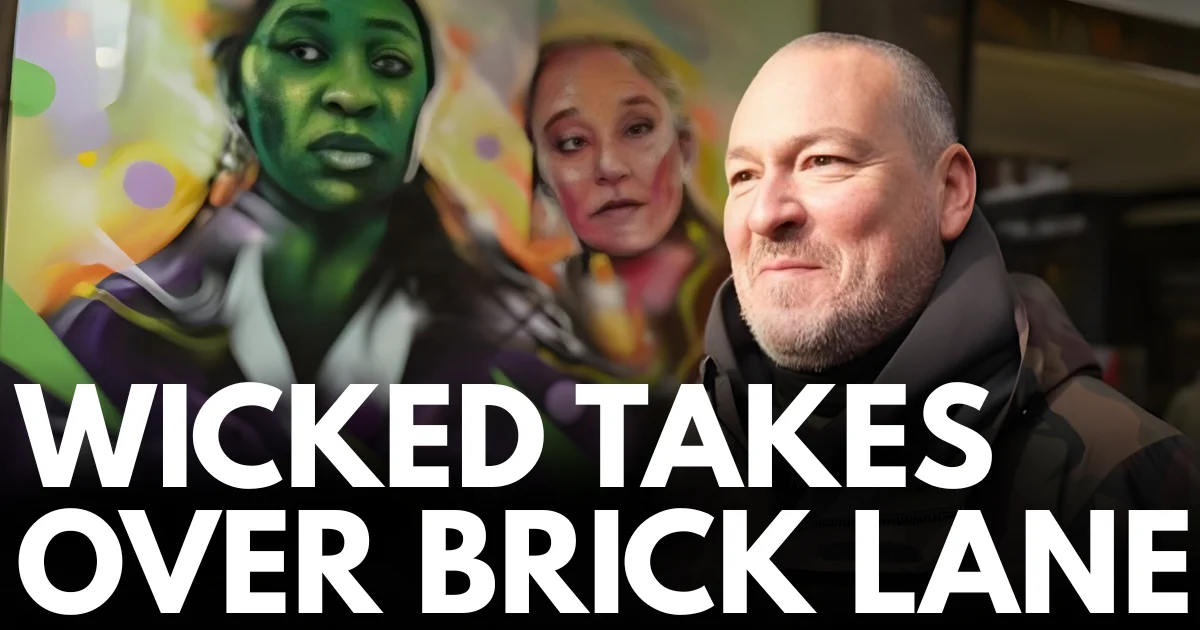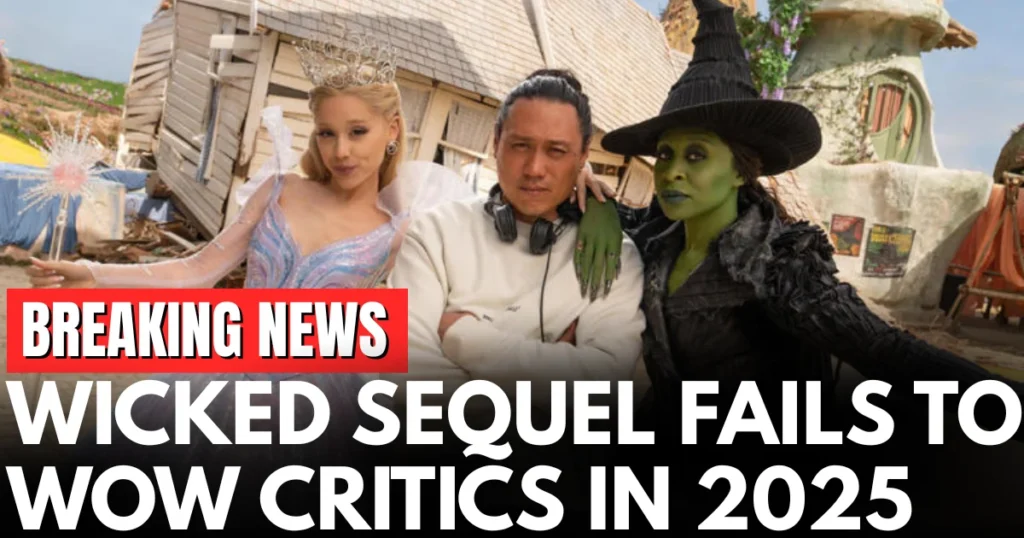London’s Brick Lane transformed yellow to promote new Wicked film. Marketing spectacle, cultural impact, and film promotion strategy analyzed.
Table of Contents
London’s Brick Lane Transforms into Yellow Wonderland to Promote New Wicked Film
London’s historic Brick Lane underwent a dramatic transformation as Universal Pictures turned the iconic street completely yellow to promote the highly anticipated “Wicked” film. The bold marketing spectacle covered storefronts, street fixtures, and public spaces in the signature golden hue associated with Glinda the Good Witch.
The immersive promotional campaign represents modern film marketing’s evolution toward experiential, Instagram-worthy moments that generate social media buzz. For marketing professionals and entertainment industry observers, this activation demonstrates how major studios create cultural moments extending far beyond traditional advertising.
The Spectacular Transformation
Universal Pictures executed an ambitious campaign transforming Brick Lane’s distinctive character through comprehensive yellow theming.
Visual transformation elements:
Storefronts along the famous street received temporary yellow coverings creating cohesive visual impact. Local businesses participated in the promotion with many establishments incorporating yellow decorations and Wicked-themed elements.
Street furniture including benches, trash bins, and lamp posts were wrapped or painted in coordinating yellow shades. The comprehensive approach ensured that every visual element contributed to the immersive experience.
Photo opportunities strategically placed throughout the area encouraged visitors to capture and share images. Instagram-friendly installations provided backdrops designed specifically for social media content creation.
Temporary signage and interactive displays educated visitors about the film while creating entertainment value. The campaign balanced promotional messaging with genuine experiential enjoyment.
Local business participation:
Restaurants and cafes developed yellow-themed menu items and special promotions. Food and beverage offerings ranged from golden cocktails to yellow-frosted desserts capitalizing on the campaign.
Retail shops created Wicked-inspired displays and limited merchandise. Local businesses leveraged the increased foot traffic through themed products and services.
Street vendors and market stalls incorporated yellow elements into their presentations. The cooperative approach created unified experience benefiting both the film promotion and local commerce.
Cultural Significance of Brick Lane
The choice of Brick Lane as the campaign location carries particular significance given the street’s cultural importance and tourist appeal.
Historical context:
Brick Lane represents one of London’s most culturally diverse and historically rich areas. The street’s evolution through centuries reflects waves of immigration and cultural exchange.
Known particularly for Bengali community presence and excellent curry restaurants, Brick Lane attracts both locals and international tourists. The area’s distinctive character makes it a natural venue for experiential marketing.
Street art, vintage shops, and weekend markets contribute to Brick Lane’s reputation as a creative hub. This creative energy aligns well with theatrical and artistic promotion like the Wicked campaign.
Tourism and foot traffic:
Brick Lane ranks among London’s top tourist destinations attracting millions annually. High visitor numbers maximize promotional campaign exposure and social media amplification.
Weekend markets draw particularly large crowds creating ideal conditions for viral marketing moments. The timing of promotional activations considers peak visitation patterns.
Film Marketing Strategy Evolution
The Brick Lane transformation exemplifies broader trends in entertainment marketing moving beyond traditional advertising approaches.
Experiential marketing advantages:
Creating physical experiences generates stronger emotional connections than passive advertisement viewing. Participants remember and share experiences more readily than conventional commercials.
Social media integration transforms every visitor into potential content creator and brand ambassador. User-generated content extends campaign reach exponentially beyond initial activation costs.
Press coverage of spectacular installations provides free media attention multiplying marketing investment returns. Journalists and influencers naturally cover visually striking campaigns.
Comparative marketing approaches:
Traditional advertising including television commercials, print ads, and billboards still plays roles in film promotion. However, experiential activations create complementary buzz that traditional methods cannot achieve.
Digital advertising through social platforms enables targeted reach and measurable engagement. Coordinated campaigns combine physical activations with digital amplification strategies.
Celebrity appearances and red carpet events generate different publicity types focusing on star power. The Brick Lane approach creates participatory experiences accessible to general public.
Economic Impact on Local Community
Major promotional campaigns bring both opportunities and challenges for host communities.
Business benefits:
Increased foot traffic during campaign periods boosts sales for local businesses. Restaurants, shops, and market vendors experience higher customer volumes.
Social media exposure showcases Brick Lane to global audiences potentially driving future tourism. Viral images featuring local establishments provide free international advertising.
Collaborative promotional opportunities allow businesses to create themed offerings. Limited-time special products capitalize on temporary increased interest.
Community considerations:
Large crowds can create congestion affecting local residents and regular customers. Balancing promotional benefits with community impact requires careful planning.
Temporary installations sometimes disrupt normal business operations during setup and removal. Coordination with local stakeholders minimizes inconvenience.
Cultural sensitivity matters when commercial promotions occur in historically significant areas. Respectful integration preserves community character while enabling marketing activities.
Social Media and Viral Marketing
The campaign’s design specifically targets social media sharing and viral content creation.
Instagram and TikTok optimization:
Photo-worthy installations with clear visual appeal encourage visitors to create content. Platform algorithms favor visually striking, cohesive imagery that this campaign provides.
Hashtag campaigns create trackable engagement metrics. Unified hashtags aggregate user-generated content making impact measurable.
Influencer partnerships amplify reach beyond organic sharing. Paid collaborations with content creators ensure professional quality content reaches target demographics.
Viral content characteristics:
Unusual, unexpected elements capture attention in crowded social feeds. A completely yellow street provides novelty that standard promotions lack.
Accessible participation opportunities enable everyone to create content regardless of production expertise. Simple photo opportunities democratize content creation.
Shareable moments that friends want to show each other drive organic reach. The transformation provides conversation starters and shared experiences.
Global Film Marketing Campaigns
The Brick Lane activation represents one element in Wicked’s comprehensive global marketing strategy.
Multi-market approach:
Different cities worldwide receive customized promotional activations. London’s Brick Lane transformation complements campaigns in other major markets.
Cultural adaptation ensures promotions resonate locally while maintaining brand consistency. Each market receives approaches suited to local contexts and preferences.
Integrated campaign elements:
Television commercials introduce story and characters to broad audiences. Traditional advertising establishes baseline awareness that experiential marketing enhances.
Digital advertising enables precise targeting and retargeting. Online campaigns capture those unable to visit physical activations.
Merchandise and retail partnerships extend brand presence into everyday consumer environments. Products ranging from makeup to fashion create ongoing promotional touchpoints.
Return on Investment Considerations
Major promotional activations require significant investment raising questions about measurable returns.
Measuring campaign success:
Social media metrics including impressions, engagements, and hashtag usage provide quantifiable data. Digital analytics track conversation volume and sentiment.
Earned media value calculates the equivalent cost of press coverage generated. Free publicity from news coverage multiplies direct marketing spending.
Box office performance ultimately determines campaign effectiveness. Opening weekend numbers reflect cumulative impact of all marketing efforts.
Cost-benefit analysis:
Spectacular activations cost substantially more than traditional advertising placements. However, multi-channel impact including social media, press coverage, and experiential value justifies investment.
Long-term brand building extends beyond immediate film release. Successful campaigns create cultural moments remembered beyond opening weekend.
Precedents and Similar Campaigns
Film studios increasingly employ location-based experiential marketing creating memorable promotional moments.
Notable previous campaigns:
“Barbie” transformed various global locations in signature pink creating similar social media phenomena. The color saturation approach proved highly effective for brand visibility.
Immersive pop-up experiences for franchises like Marvel and Harry Potter created destination attractions. Temporary installations draw dedicated fans willing to travel for exclusive experiences.
Industry trend analysis:
Experiential marketing investment grows as studios recognize its unique value. Physical activations create shareable moments that digital advertising alone cannot achieve.
Integration with social media platforms drives strategic planning. Campaigns design experiences specifically for content creation and sharing.
What Happens After the Campaign
Temporary installations eventually come down but impacts continue beyond physical presence.
Post-campaign effects:
Archived social media content provides lasting promotional value. Images and videos remain searchable and shareable indefinitely.
Local businesses may retain modified yellow elements extending campaign visibility. Continued themed offerings maintain connection to promotional moment.
Community memories and stories become part of area’s cultural narrative. Significant campaigns enter local lore as memorable moments in community history.
Future marketing implications:
Success or failure informs future promotional strategy decisions. Studios analyze campaign performance data when planning subsequent releases.
Other properties might attempt similar activations learning from Wicked’s approach. Successful campaigns inspire iterations and variations across entertainment industry.
FAQ SECTION
1. Why did they turn Brick Lane yellow for the Wicked film?
Universal Pictures transformed Brick Lane yellow as an immersive experiential marketing campaign promoting the Wicked film. The yellow color represents Glinda the Good Witch’s signature hue from the musical and movie. This type of spectacular, Instagram-worthy activation generates social media buzz, press coverage, and cultural moments extending promotional impact far beyond traditional advertising. The campaign creates participatory experiences where visitors become content creators sharing images globally.
2. What is Brick Lane and why was it chosen?
Brick Lane is one of London’s most culturally diverse and historically rich streets, known for Bengali community presence, excellent restaurants, street art, vintage shops, and weekend markets. It ranks among London’s top tourist destinations attracting millions annually. The location was chosen for its high foot traffic, creative reputation, tourist appeal, and social media presence. The street’s distinctive character makes it an ideal venue for experiential marketing that requires significant public engagement.
3. How does experiential marketing differ from traditional advertising?
Experiential marketing creates physical, participatory experiences generating emotional connections and social media content, while traditional advertising delivers passive messages through commercials and print ads. Experiential activations transform visitors into content creators and brand ambassadors, with user-generated content extending campaign reach exponentially. Physical installations also generate press coverage providing free media attention. The Brick Lane transformation creates shareable moments and cultural events that traditional advertising cannot achieve.
4. Did local businesses benefit from the promotion?
Yes, local businesses experienced increased foot traffic during the campaign, with restaurants, shops, and market vendors seeing higher customer volumes. Many establishments participated by creating yellow-themed menu items, special promotions, and Wicked-inspired displays. Social media exposure showcased Brick Lane to global audiences potentially driving future tourism. However, the campaign also created challenges including crowd congestion and temporary disruptions during installation setup and removal.
5. How do studios measure success of campaigns like this?
Success metrics include social media impressions, engagements, and hashtag usage providing quantifiable digital data; earned media value calculating equivalent cost of press coverage generated; conversation volume and sentiment analysis; and ultimately box office performance, particularly opening weekend numbers. Studios analyze how experiential activations contribute to overall marketing impact alongside traditional advertising, digital campaigns, and other promotional efforts. Long-term brand building and cultural moment creation represent additional success factors beyond immediate measurable returns.
CONCLUSION
The transformation of London’s Brick Lane into a yellow wonderland promoting the Wicked film exemplifies modern entertainment marketing’s evolution toward experiential, shareable moments. The campaign successfully generated social media buzz, press coverage, and community engagement extending promotional impact far beyond traditional advertising reach.
For marketing professionals, the activation demonstrates how physical installations create cultural moments that resonate across digital platforms. The integration of location-based experiences with social media sharing creates multiplier effects justifying significant campaign investments.
Local communities experienced both benefits through increased foot traffic and challenges managing crowds and temporary disruptions. Successful experiential marketing requires balancing promotional objectives with community impact and stakeholder coordination.
As film studios continue seeking innovative ways to break through crowded entertainment markets, spectacular activations like the Brick Lane transformation will likely inspire similar campaigns. The success or failure of such efforts ultimately appears in box office numbers, but the broader cultural impact creates value extending beyond opening weekend.
Have you visited any film marketing activations? What makes promotional campaigns memorable and shareable? Share your experiences in the comments!

